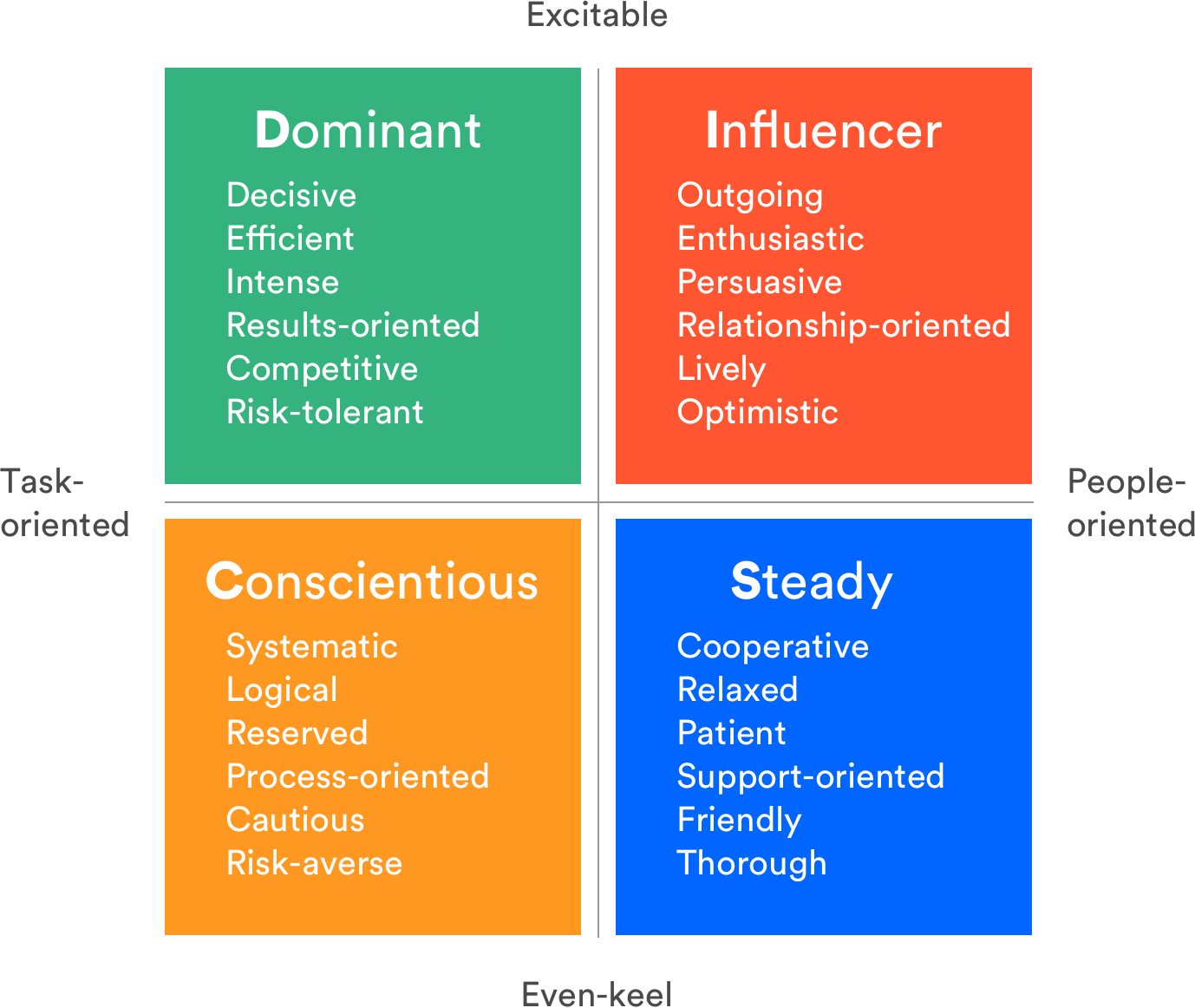5-second summary
- The DiSC personality assessment framework can help you navigate communication with your colleagues in a way that resonates with them.
- This model comprises four personality types – dominant, influencer, conscientious, and steady – and gives you tips on collaborating with different people in general.
- Understanding your teammates’ communication styles is even more important when you’re frequently using video or chat tools.
The differences between communication styles often cause more agony than they really need to. It’s common enough to misinterpret an interaction when you’re standing face to face. But it’s even easier to get your wires crossed when you’re on a video call or conversing via chat. In the age of asynchronous teamwork, communication skills matter more than ever.
Paying attention to which communication styles your teammates gravitate toward can improve your interpersonal skills, build trust, and help you get more done with less frustration.
While we benefit from working with people with diverse skills and personality types, sometimes it can feel like navigating the interpersonal dynamics is the tax we pay on having the right people in the room – particularly when it comes to communication. But there’s another way of thinking about it.
Understanding the differences in the way we communicate is actually an investment. The payoff? Stronger workplace relationships, which is a major predictor of employee engagement, and therefore of productivity.
DiSC personality types
There are a few different frameworks for understanding communication styles. Do a quick Google search and you’ll find the classic four: assertive, aggressive, passive-aggressive, and passive. But these are all about a person’s outbound communication, and say nothing about what works best for them when it comes to inbound communication.
When figuring out how you can communicate effectively with someone, it’s important to understand their broader personal style. Are they direct? Analytical? Sociable? Business-like? Behavioral traits can clue you into how people respond to information, which, in turn, helps you anticipate how to communicate in a way that strengthens the relationship.
The DiSC profile provides a useful framework for our purposes here. Through a self-assessment tool, DiSC categorizes your primary style as Dominant, Influencer, Steady, or Conscientious. Most people have shades of each, but here we’ll be focusing on their primary style.
1: Dominant
People who have a “dominant” personal style (known in similar frameworks as a “director” or “driver”) love action and are focused on results. They prefer to think about the big picture and leave implementation details to others – there’s a pretty good chance your boss’s style is primarily dominant. Patience and sensitivity are within a “dominant” communicator’s grasp, but require some effort.
A few things to keep in mind when communicating with “dominants”:
You’ll do best if you…
- Get right down to business and stay on topic.
- Be prepared to field follow-up questions on the spot so you can answer with confidence.
- Expect them to be decisive and fairly blunt.
Avoid…
- Taking their bluntness, follow-up questions, and/or impatience personally.
- Making promises you can’t deliver on.
- Expecting them to open up about their weekend plans.
Dominants are often accomplished, excitable, and love a good challenge. They’re the ones you want to recruit for that moon-shot project you’ve been noodling on.
2: Influencer
People with the “influencer” personal style (known in similar frameworks as an “initiator” or “socializer”) are your classic “people people.” They’re friendly, upbeat, and always on the pulse of the latest trends. They thrive on interpersonal relationships, which makes them ace collaborators. A word of caution, though: long-term focus and follow-through aren’t their strong suits, so it’s best to engage them in shorter collaborative bursts.
A few things to keep in mind when communicating with “influencers”:
You’ll do best if you...
- Approach them in a casual manner and let your sense of humor show.
- Put details and facts in writing for them to refer back to after a verbal conversation.
- Expect them to be a little too optimistic about ideas, as well as their own abilities and the abilities of those around them.
Avoid…
- Talking down to them or being curt.
- Trying to confine the conversation or stifle their freedom to express ideas and emotions.
- Expecting them to dive deep into the details with you.
Influencers strive to be emotionally honest and are quick to trust those around them. If you’re trying to reshape the culture on your team, an influencer might be the perfect partner in crime.
3: Steady
People who have a “steady” personal style (known in similar frameworks as a “relator” or “harmonizer”) emphasize cooperation and are loathe to upset the apple cart. They value consistency, stability, and loyalty. You’ll often find them in service-flavored roles in customer support or IT help desk. They can adapt quickly when they have to, but may need some extra encouragement along the way.
A few things to keep in mind when communicating with “steadies”:
You’ll do best if you…
- Practice active listening, and confirm that you’ve heard them by summarizing what they’ve just said to you.
- Approach them with a relaxed vibe and break the ice by acknowledging a recent contribution they’ve made.
- Expect them to ask for details.
Avoid…
- Rushing them into a decision.
- Assuming they support an idea 100% just because they don’t voice opposition.
- Expecting them to intuit priorities and deadlines – it’s helpful if you spell those out.
Steadies are even-keel people who love to be in a cooperative environment where everyone understands their roles and responsibilities. If your team is in turmoil, a steady likely won’t lead the effort to restore normalcy, but they’ll be a strong ally.
4. Conscientious
People of the “conscientious” personal style (known in similar frameworks as an “analyzer” or “thinker”) prioritize precision and place a high value on competency. They jump at the chance to demonstrate their expertise and build new skills – just the sort of person you’re likely to find in engineering, data science, or analyst roles. They aren’t unfriendly, per se, but may be less likely to chat you up about weekend plans or volunteer to organize a team dinner.
A few things to keep in mind when communicating with “conscientious” types:
Try to…
- Provide as many details as possible up front, organized as systematically as you can.
- Give them clear expectations and space to work independently (they’re really good at it!).
- Expect them to double- and triple-check all the relevant info before making a decision.
Avoid…
- Framing feedback on their work as “criticism.”
- Responding to them emotionally – use words like “know” or “think” instead of “feel.”
- Expecting them to ease into a conversation with chit-chat.
Conscientious types are not only cautious, but highly systematic. They’re the person you want to partner with when assessing risks or running a pre-mortem for the project you’re about to launch.
Navigating communication styles at work doesn’t have to be stressful
Thinking back, many (if not most) of the stressful interactions I’ve had were caused in part by a mismatch in communication styles. By the same token, the most effective communication I’ve had with coworkers featured a level of comfortable formality, complementary body language, and a general feeling that we “get” each other.
Communicating with teammates in a way that resonates with them is an express lane to building trust. It’s a way of saying “I see you for who you are, and I’ve got your back.” And guess what? They’ll have your back, too.
Special thanks to Sarah Goff-Dupont for her contribution to this article.





 )
) 








































